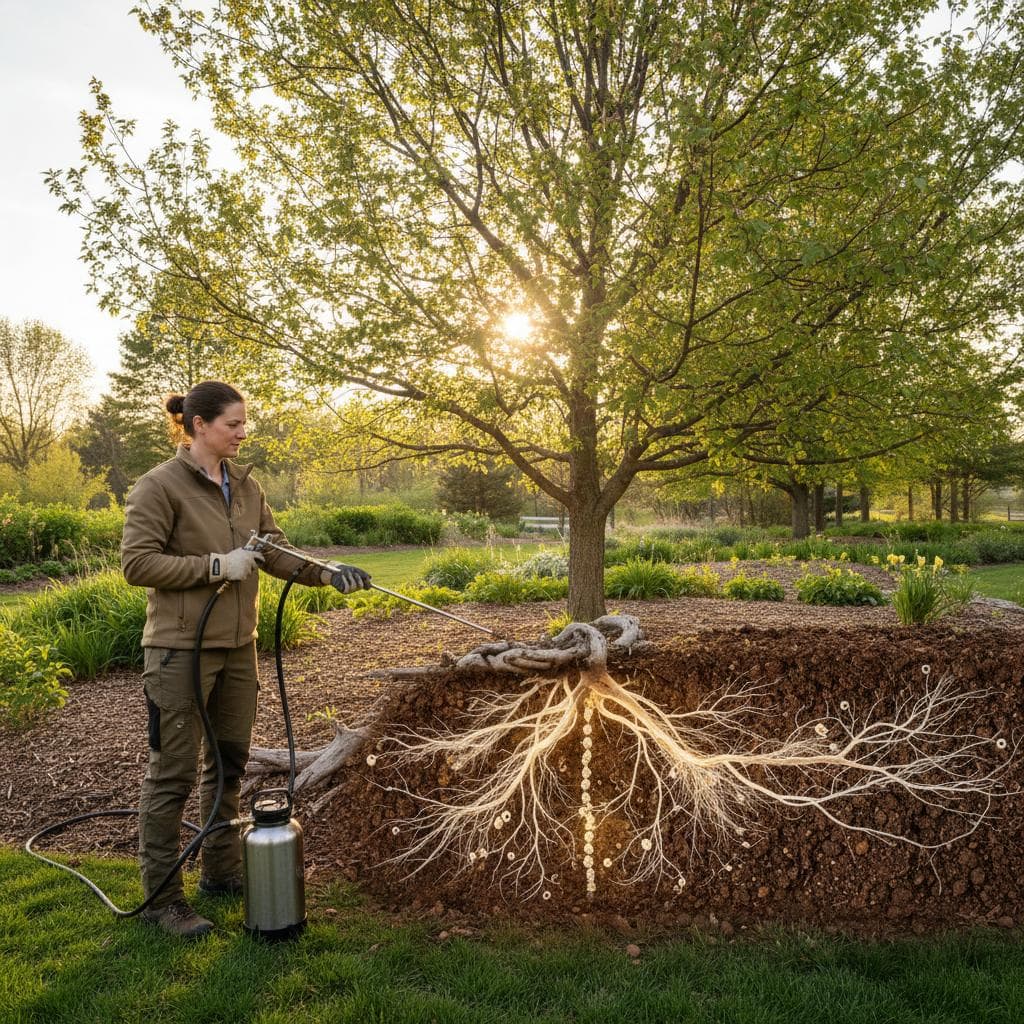Understanding Mycorrhizal Fungi and Their Role in Tree Health
Trees rely on intricate underground networks for survival, and mycorrhizal fungi form a cornerstone of this system. These microscopic organisms create symbiotic relationships with tree roots, extending the root system's reach into the soil. In return for carbohydrates from the tree, the fungi deliver essential water and nutrients that might otherwise remain inaccessible.
In natural settings, healthy forests teem with these partnerships. However, urban environments, construction activities, and chemical treatments often disrupt them, leaving trees vulnerable to stress. Mycorrhizal fungi injections address this by directly introducing beneficial strains to restore balance and vigor.
The Science Behind Mycorrhizal Injections
Mycorrhizal injections involve delivering fungal spores or mycelium directly into the root zone through specialized tools. This method ensures precise placement, bypassing surface barriers like compacted soil or mulch layers. Professionals typically use high-pressure injectors to deposit the fungi at depths where roots actively grow, often 6 to 12 inches below the surface.
Two primary types exist: ectomycorrhizal fungi, which form sheaths around roots and suit conifers like pines, and endomycorrhizal fungi, which penetrate root cells and benefit deciduous trees such as oaks and maples. Selecting the correct type based on species maximizes effectiveness. Once injected, the fungi colonize roots within weeks, establishing networks that can span vast areas and connect multiple trees.
Benefits of Mycorrhizal Fungi Injections
These treatments yield multiple advantages for tree health and surrounding ecosystems. First, they enhance nutrient uptake, particularly phosphorus and nitrogen, reducing the need for synthetic fertilizers. Trees absorb up to 90 percent more resources through fungal hyphae, leading to denser foliage and stronger growth.
Second, injections improve drought resistance by increasing water efficiency. The extended fungal network acts like an underground pipeline, drawing moisture from deeper soil layers during dry spells. Studies show treated trees maintain hydration levels 30 to 50 percent longer than untreated ones.
Additionally, these fungi bolster disease resistance by outcompeting pathogens and producing natural antibiotics. Soil structure improves as hyphae bind particles, preventing erosion and enhancing aeration. Over time, injected sites develop richer microbial communities, supporting broader biodiversity.
Costs for injections range from 50 to 200 dollars per tree, depending on size, location, and provider. While initial expenses apply, long-term savings arise from decreased watering, fertilizing, and replacement needs. Landscapes with mature trees see the most dramatic transformations, regaining lost vitality within one to two growing seasons.
Proper Application and Timing
Professional arborists assess tree condition, soil type, and species before proceeding. They conduct soil tests to identify deficiencies and select compatible fungi strains. Injections occur via a grid pattern around the drip line, ensuring even distribution without damaging roots.
Ideal timing aligns with root growth phases, such as spring or fall in temperate climates. Avoid frozen or waterlogged ground, as these conditions hinder fungal establishment. Post-injection, light watering aids colonization, but overwatering risks washing away the inoculum.
Homeowners may use granular inoculants for new plantings, but mature tree injections demand expertise. Incorrect depth or dosage can limit results, underscoring the value of certified services.
Maintenance Tips to Sustain Fungal Partnerships
To maximize the longevity of mycorrhizal networks, implement these practices:
- Avoid Over-Fertilizing: Excessive synthetic fertilizers disrupt fungal populations. Opt for slow-release or organic alternatives that support gradual nutrient availability.
- Minimize Soil Compaction: Restrict foot traffic and heavy machinery near the root zone. Compacted soil limits oxygen flow and impedes hyphal expansion.
- Water Deeply and Infrequently: Promote deep root development by applying thorough waterings spaced out over time. This encourages fungi to thrive in lower soil layers.
- Add Organic Mulch: Apply a 2- to 3-inch layer of shredded bark or leaves around the base. Mulch moderates temperature fluctuations and provides decomposing material for fungal nourishment.
- Monitor Tree Health Annually: Inspect for signs of decline, including sparse canopy, yellowing leaves, or cracking bark. Prompt intervention preserves the symbiotic bond.
Regular adherence to these steps extends benefits for 5 to 10 years or more, depending on environmental factors.
Frequently Asked Questions
What do mycorrhizal fungi injections do for trees?
These injections introduce symbiotic fungi that integrate with tree roots, amplifying the root system's soil exploration. This alliance boosts absorption of water and nutrients, elevates drought tolerance, and fortifies defenses against diseases and pests.
How long do the benefits of mycorrhizal injections last?
Under supportive conditions, benefits persist for several years as fungal colonies grow and stabilize. Networks endure and proliferate, though intense disturbances like tillage, harsh chemicals, or prolonged droughts may diminish their vitality.
Can I apply mycorrhizal fungi myself?
Basic inoculants suit planting new trees, where simple mixing into backfill suffices. For established or distressed trees, injections require precise tools and expertise to achieve optimal depth and distribution. Professionals ensure comprehensive coverage and higher success rates.
Are mycorrhizal fungi injections safe for pets and the environment?
These treatments use naturally occurring organisms, rendering them non-toxic and eco-friendly. They mimic processes in undisturbed ecosystems, posing no threats to pets, wildlife, pollinators, or water sources.
When is the best time to apply mycorrhizal injections?
Applications work year-round on unfrozen soil, with peak efficacy during periods of active root expansion. Moderate temperatures and sufficient moisture facilitate rapid fungal integration.
Do all trees benefit from mycorrhizal fungi?
Nearly all trees form these associations, though strain compatibility varies. Conifers often pair with ectomycorrhizal types, while broadleaf species thrive with endomycorrhizal varieties. Consult experts to match fungi to specific needs.
Implementing Mycorrhizal Treatments for Lasting Results
Reestablishing tree-fungi symbioses represents a proactive strategy for resilient landscapes. These injections provide a targeted, natural remedy for trees facing urban challenges or soil degradation. Established partnerships transform soil into a dynamic resource, yielding healthier trees with minimal ongoing intervention.
If observations reveal stunted growth, wilting branches, or barren soil, engage a certified arborist for evaluation. Customized injections and follow-up care restore ecological harmony, enabling trees to flourish amid demanding conditions.
